The Economics and Statistics Division maintains archives of previous publications for accountability purposes, but makes no updates to keep these documents current with the latest data revisions from Statistics Canada. As a result, information in older documents may not be accurate. Please exercise caution when referring to older documents. For the latest information and historical data, please contact the individual listed to the right.
<--- Return to Archive
For additional information relating to this article, please contact:
November 20, 2018GOVERNMENT FINANCIAL STATISTICS, 2017 Statistics Canada has published the latest Consolidated Government Finance Statistics for 2017 including consolidated results for provincial-territorial as well as local governments. These data are based on the international government financial statistical standard and, as such, may differ in their presentation from similar concepts reported in Public Accounts and other financial statements. Statistics Canada's data allows for comparability across jurisdictions, as well as consistency with the government consumption and investment data reported in macroeconomic accounts.
The following analysis compares the per capita results for consolidated provincial-and-local governments. Local governments are consolidated into the analysis because each provincial government may assign different responsibilities to municipal or local governments.
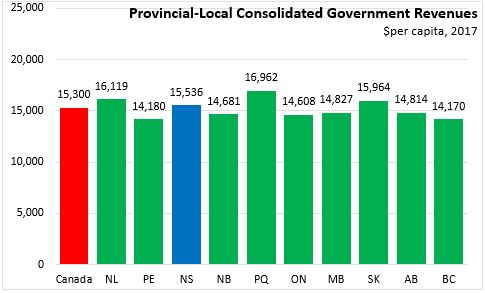
Total revenues per capita vary across the country, with Nova Scotia's provincial-local government revenues amounting to $15,536 per capita. This is similar to the Canadian average of $15,300 per capita. The highest per capita revenues are in Quebec, where the government offers a different mix of public services, including delivering some services that are otherwise delivered by the Federal government (the value of the Quebec abatement to Federal taxes was $559 per capita and is included in revenue figures presented here). The lowest per capita revenues are in British Columbia.

Although Nova Scotia's provincial-local government revenues are similar to the national per capita average, this makes up a larger portion of the province's relatively small GDP per capita.
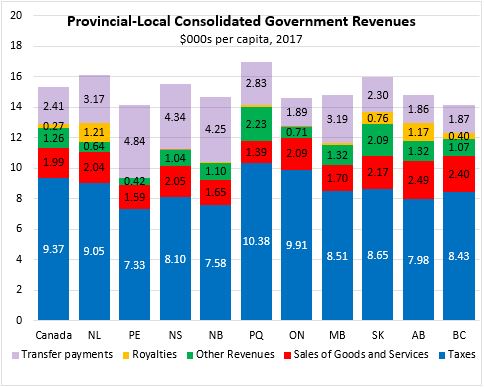
Taxes are the largest source of provincial-local government revenues, amounting to $9,368 per capita across Canada. Nova Scotia's tax revenues are over $1,200 per capita lower than the national average at $8,096 per capita. The highest tax revenues are in Quebec (including $559/capita Quebec abatement of Federal taxes).
Beyond taxes and user fees, provincial-local governments generate revenues from social insurance premiums (such as workers compensation), fiscal transfer payments, interest/dividend income, royalties and sales of goods/services. Those provinces that are Equalization recipients report higher fiscal transfer revenues per capita, particularly in Atlantic Canada and Manitoba. Provinces with substantial oil and gas sectors (and to a lesser extent hydroelectricity and forestry) report stronger royalty income. Saskatchewan and Quebec also report substantially higher revenues from other sources, though this may include specific items that cannot be classified with others. Revenue from sales of goods and services includes tuition fees.
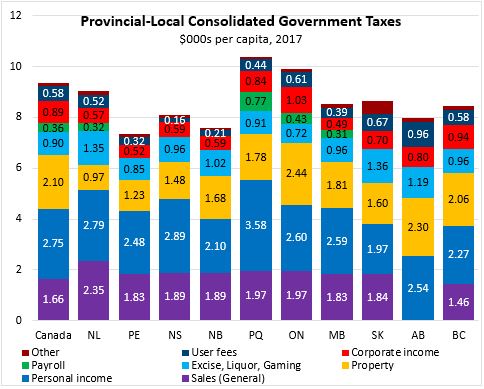
Tax revenues break down into 8 major categories, including personal income taxes, corporate income taxes, general sales taxes, excise taxes/profits of fiscal monopolies, payroll taxes, property taxes, user fees and other taxes. The amount of revenues generated by these taxes reflects both the tax system itself (tax rates, deductions, credits, number of taxes levied) as well as overall economic conditions.
There are also differences in specific taxes across Canada. Alberta has no general sales tax. Alberta relies more on property taxes and user fees for revenues than in most other provinces. Only Newfoundland and Labrador, Quebec, Ontario and Manitoba levy payroll taxes. Corporate income taxes are higher in Ontario, Alberta, Quebec and Saskatchewan. User fee revenues per capita are notably higher Ontario, Alberta and Saskatchewan.
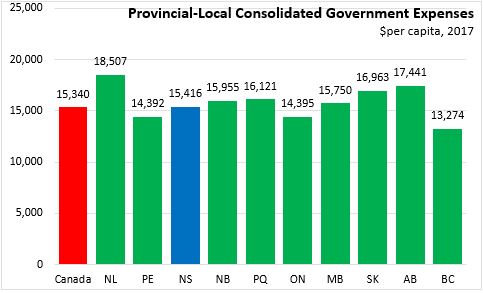
Total provincial-local government expenditures in Canada were $15,340 per capita. Nova Scotia's provincial-local government expenditures were slightly higher at $15,416 per capita. The highest expenditures were in Newfoundland and Labrador, Alberta and Saskatchewan while the lowest were in Ontario, Prince Edward Island and British Columbia.

As with provincial-local government revenues, modest differents in per capita expenditures appear larger when measured relative to GDP per capita, which is substantially larger in resource-producing provinces (even though commodity prices have fallen since 2014).
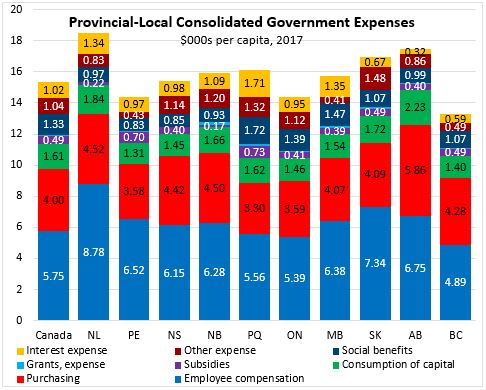
Employee compensation is the largest component of provincial-local expenditures, amounting to $5,754 per capita. The highest employee compensation expenditures per capita are found in Newfoundland and Labrador, Saskatchewan and Alberta. The lowest are reported in Quebec, Ontario and British Columbia. Nova Scotia's per capita employee compensation expenditures were $6,153.
Purchases of goods and services was the next largest expenditure category with an average provincial-local government expenditure of $4,004 per capita. Expenditures on goods and services were highest in Alberta and Newfoundland and Labrador and lowest in Quebec.
Interest expenses depend on net financial liabilities and costs of funds. Across Canada, provincial-local expenditures on interest payments averaged $1,015 per capita while interest costs were $976 per capita in Nova Scotia. The highest interest expenditures were in Quebec, Newfoundland and Labrador and Manitoba. The lowest interest expenditures were in Saskatchewan, British Columbia and Alberta.
Subsidies (particularly in agriculture) are uneven across the country, with the highest payments in Quebec and Prince Edward Island.
Social assistance and family/employment benefit expenditures per capita were $1,334 per capita across Canada, including notably higher expenditures in Quebec, Ontario and Manitoba. Alberta and Atlantic Canada reported the lowest social benefit expenditures with Nova Scotia's amounting to $854 per capita.
Statistics Canada reported on net operating balances as well as net financial worth of provincial-local governments. Note that although these concepts are similar, net financial wealth differs from provincial government Net Debt reported in Public Accounts while net operating balance differs from provincial surplus/deficit.
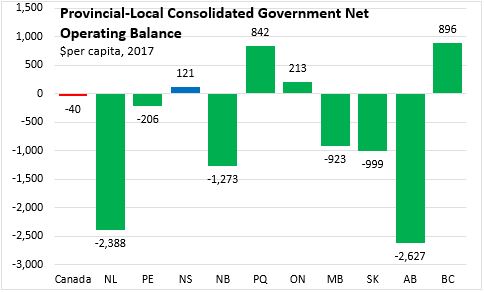
Four Provinces reported provincial-local governments with a positive net operating balance in 2017: British Columbia, Quebec, Ontario and Nova Scotia. The largest net operating deficits were reported in Alberta and Newfoundland and Labrador. The aggregate provincial-local government sector reported a deficit of $40/capita.
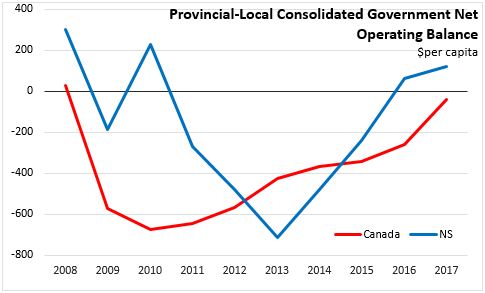
Nova Scotia's operating balance has improved in the last four years, as has the average across Canada. Much of the national improvement is attributable to Quebec British Columbia, Nova Scotia and Ontario. However, resource-producing provinces as well as Manitoba and New Brunswick continue to report negative net operating balances in their provincial-local governments.
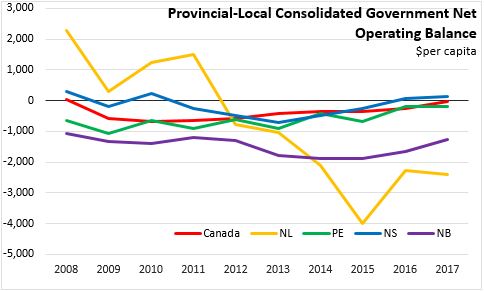

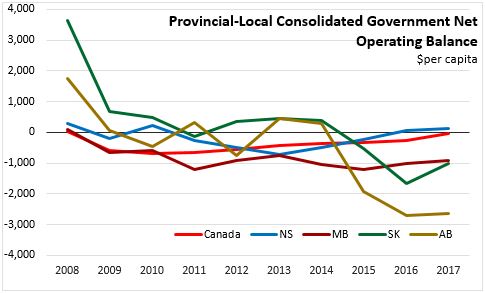
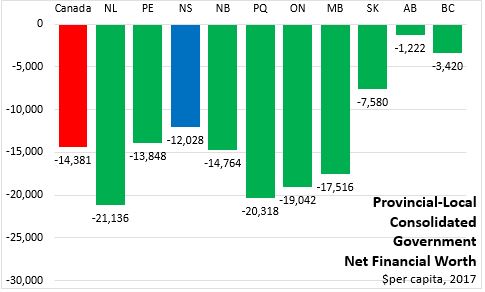
All provinces report negative net financial worth, with an average of -$14,381 per capita across Canada. The three westernmost provinces have the smallest negative net financial worth, followed by Nova Scotia at -$12,028 per capita. The highest negative net financial worth is reported in Newfoundland and Labrador, Quebec and Ontario.



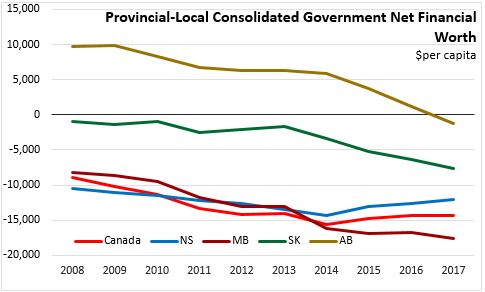
After the financial crisis of 2007-2008, all PTLGs reported an erosion in net financial worth but positive net operating balances have contributed to recovery for Quebec, British Columbia, Ontario, Nova Scotia and Prince Edward Island. The largest deterioration between 2008 and 2017 was reported in Newfoundland and Labrador, Alberta and Saskatchewan. The least erosion in net financial liabilities over this period were reported in British Columbia and Nova Scotia.
Statistics Canada: Table 10-10-0017-01 Canadian government finance statistics for the provincial and territorial governments (x 1,000,000), Table 17-10-0009-01 Population estimates, quarterly, Table 36-10-0222-01 Gross domestic product, expenditure-based, provincial and territorial, annual (x 1,000,000)
<--- Return to Archive